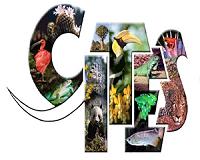| . |  |
. |
Washington DC (SPX) Mar 25, 2010 When we notice somebody pointing at something, we automatically look in the direction of the gesture. In humans, the ability to understand this type of gesturing (known as declarative communication) may seem to be an automatic response, but it is actually a sign of sophisticated communication behavior. Numerous studies have tried to determine if great apes (for example, chimpanzees and bonobos) are able to understand declarative communication, but results have been mixed. Psychological scientists Heidi Lyn and William Hopkins from Agnes Scott College and Jamie Russell from the Yerkes National Primate Research Center examined if exposure to different human communicative environments would affect understanding of declarative signals in chimpanzees and bonobos. Three groups of apes were tested in this study. One group consisted of chimpanzees that had been raised in standard laboratory housing; although they had regular contact with humans, these interactions were limited to basic animal-care contexts such as feeding. The other two groups of apes consisted of chimpanzees and bonobos that had been raised in socio-linguistically rich environments, where they were routinely exposed to complex communicative interactions with humans. In the current experiment, the apes participated in an object-choice task - they had to choose between two containers, one of which contained a food reward. The placement of the food in one of the containers was hidden from the apes, and a researcher indicated the correct container by pointing, vocalizing, or both. The results, reported in Psychological Science, a journal of the Association for Psychological Science, indicate interesting differences between chimps and bonobos raised in socio-linguistically rich environments and chimps raised in standard laboratory housing. The bonobos and chimps that had been reared in the highly communicative environments performed significantly better than chimps that had been reared in standard laboratory settings in the pointing, vocalizing, and pointing-and-vocalizing conditions. Further analysis revealed that the best results occurred when the researcher simultaneously pointed and vocalized towards the correct container. This finding supports earlier studies that suggest visual cues enhance performance on auditory tasks. These results indicate that apes may have the potential for understanding declarative communication and this potential may be achieved in specific environments. The authors conclude, "Because the ability to acquire declarative comprehension is common to both apes and humans, researchers must look elsewhere for a candidate biological change that allowed for the evolution of human language and cognition."
Share This Article With Planet Earth
Related Links Psychological Science Darwin Today At TerraDaily.com
 Sharks, elephants to reappear on CITES agenda
Sharks, elephants to reappear on CITES agendaDoha (AFP) March 24, 2010 Decisions to tighten or relax trade protection for elephants in Zambia and two species of sharks prized for their fins or meat could be overturned on the last day of a key UN wildlife meeting on Thursday. The final plenary session of the Convention on the International Trade in Endangered Species (CITES) validates decisions taken over the previous 12 days, but a motion to reopen debate suppo ... read more |
|
| The content herein, unless otherwise known to be public domain, are Copyright 1995-2010 - SpaceDaily. AFP and UPI Wire Stories are copyright Agence France-Presse and United Press International. ESA Portal Reports are copyright European Space Agency. All NASA sourced material is public domain. Additional copyrights may apply in whole or part to other bona fide parties. Advertising does not imply endorsement,agreement or approval of any opinions, statements or information provided by SpaceDaily on any Web page published or hosted by SpaceDaily. Privacy Statement |